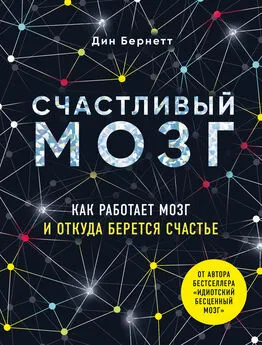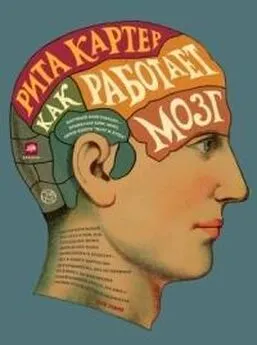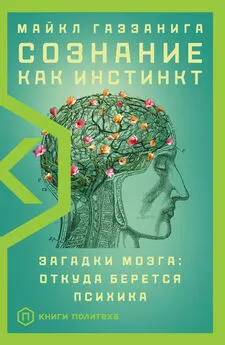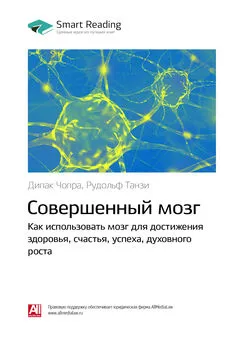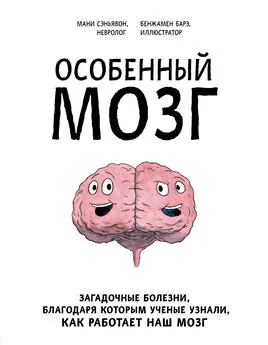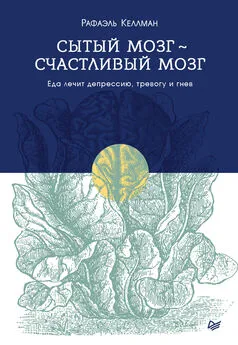Дин Бернетт - Счастливый мозг. Как работает мозг и откуда берется счастье
- Название:Счастливый мозг. Как работает мозг и откуда берется счастье
- Автор:
- Жанр:
- Издательство:Эксмо
- Год:2018
- Город:Москва
- ISBN:978-5-04-095041-6
- Рейтинг:
- Избранное:Добавить в избранное
-
Отзывы:
-
Ваша оценка:
Дин Бернетт - Счастливый мозг. Как работает мозг и откуда берется счастье краткое содержание
Счастливый мозг. Как работает мозг и откуда берется счастье - читать онлайн бесплатно ознакомительный отрывок
Интервал:
Закладка:
190
Martin, L.J., et al., Social deprivation of infant rhesus monkeys alters the chemoarchitecture of the brain: I. Subcortical regions. Journal of Neuroscience, 1991. 11 (11): p. 3344–3358.
191
Metzner, J.L. and J. Fellner, Solitary confinement and mental illness in US prisons: A challenge for medical ethics. 2010.
192
Izuma, K., D. N. Saito, and N. Sadato, Processing of the incentive for social approval in the ventral striatum during charitable donation. Journal of cognitive neuroscience, 2010. 22 (4): p. 621–631.
193
Buchanan, K.E. and A. Bardi, Acts of Kindness and Acts of Novelty Affect Life Satisfaction. The Journal of Social Psychology, 2010. 150 (3): p. 235–237.
194
Bateson, M., D. Nettle, and G. Roberts, Cues of being watched enhance cooperation in a real-world setting. Biology Letters, 2006. 2 (3): p. 412–414.
195
Rigdon, M., et al., Minimal social cues in the dictator game. Journal of Economic Psychology, 2009. 30 (3): p. 358–367.
196
Weir, K., The pain of social rejection. American Psychological Association, 2012. 43.
197
Woo, C.W., et al., Separate neural representations for physical pain and social rejection. Nat Commun, 2014. 5: p. 5380.
198
Wesselmann, E.D., et al., Adding injury to insult: Unexpected rejection leads to more aggressive responses. Aggressive Behavior, 2010. 36 (4): p. 232–237.
199
Farrow, T., et al., Neural correlates of self-deception and impression-management. Vol. 67. 2014.
200
Morrison, S., J. Decety, and P. Molenberghs, The neuroscience of group membership. Neuropsychologia, 2012. 50 (8): p. 2114–20.
201
D’Argembeau, A., On the Role of the Ventromedial Prefrontal Cortex in Self-Processing: The Valuation Hypothesis. Frontiers in Human Neuroscience, 2013. 7: p. 372.
202
Fischer, P., et al., The bystander-effect: a meta-analytic review on bystander intervention in dangerous and non-dangerous emergencies. Psychological bulletin, 2011. 137 (4): p. 517.
203
Gonçalves, B., N. Perra, and A. Vespignani, Modeling users’ activity on twitter networks: Validation of dunbar’s number. PloS one, 2011. 6 (8): p. e22656.
204
Clark, C., Brain Sex in Men and Women – From Arousal to Orgasm | Brain Blogger, in BrainBlogger. 2014.
205
Laeng, B., O. Vermeer, and U. Sulutvedt, Is beauty in the face of the beholder? PloS one, 2013. 8 (7): p. e68395.
206
Järvi, T., et al., Evolution of variation in male secondary sexual characteristics. Behavioral Ecology and Sociobiology, 1987. 20 (3): p. 161–169.
207
Georgiadis, J.R. and M. L. Kringelbach, Intimacy and the Brain: Lessons from Genital and Sexual Touch, in Affective Touch and the Neurophysiology of CT Afferents. 2016, Springer: p. 301–321.
208
Cazala, F., N. Vienney, and S. Stoléru, The cortical sensory representation of genitalia in women and men: a systematic review. Socioaffective Neuroscience & Psychology, 2015. 5: p. 10.3402/snp.v5.26428.
209
The neuroscience of Erogenous Zones. 2017; Available from: https://www.bangor.ac.uk/psychology/news/the-neuroscience-of-erogenous-zones-15794.
210
Turnbull, O.H., et al., Reports of intimate touch: Erogenous zones and somatosensory cortical organization. Cortex, 2014. 53: p. 146–154.
211
Georgiadis, J.R., Doing it … wild? On the role of the cerebral cortex in human sexual activity. Socioaffective Neuroscience & Psychology, 2012. 2: p. 17337.
212
Aggleton, E.J.P., et al., The amygdala: a functional analysis. 2000.
213
Baird, A.D., et al., The amygdala and sexual drive: insights from temporal lobe epilepsy surgery. Annals of neurology, 2004. 55 (1): p. 87–96.
214
Newman, S.W., The medial extended amygdala in male reproductive behavior a node in the mammalian social behavior network. Annals of the New York Academy of Sciences, 1999. 877 (1): p. 242–257.
215
Goldstein, J.M., Sex, hormones and affective arousal circuitry dysfunction in schizophrenia. Hormones and behavior, 2006. 50 (4): p. 612–622.
216
Shirtcliff, E.A., R. E. Dahl, and S. D. Pollak, Pubertal development: correspondence between hormonal and physical development. Child development, 2009. 80 (2): p. 327–337.
217
Alexander, G.M. and B. B. Sherwin, The association between testosterone, sexual arousal, and selective attention for erotic stimuli in men. Horm Behav, 1991. 25 (3): p. 367–81.
218
van Anders, S.M., Testosterone and sexual desire in healthy women and men. Archives of Sexual Behavior, 2012. 41 (6): p. 1471–1484.
219
Rajfer, J., Relationship Between Testosterone and Erectile Dysfunction. Reviews in Urology, 2000. 2 (2): p. 122–128.
220
Sarrel, P.M., Effects of hormone replacement therapy on sexual psychophysiology and behavior in postmenopause. Journal of women’s health & gender-based medicine, 2000. 9 (1, Supplement 1): p. 25–32.
221
Sarrel, P., B. Dobay, and B. Wiita, Estrogen and estrogen-androgen replacement in postmenopausal women dissatisfied with estrogen-only therapy. Sexual behavior and neuroendocrine responses. The Journal of reproductive medicine, 1998. 43 (10): p. 847–856.
222
Purves, D., G. Augustine, and D. Fitzpatrick, Autonomic regulation of sexual function. 2001, Sunderland: Sinauer Associates.
223
Ishai, A., Sex, beauty and the orbitofrontal cortex. International Journal of Psychophysiology, 2007. 63 (2): p. 181–185.
224
Ortega, V., I. Zubeidat, and J. C. Sierra, Further examination of measurement properties of Spanish version of the Sexual Desire Inventory with undergraduates and adolescent students. Psychological reports, 2006. 99 (1): p. 147–165.
225
Montgomery, K.A., Sexual Desire Disorders. Psychiatry (Edgmont), 2008. 5 (6): p. 50–55.
226
Gray, J.A., Brain systems that mediate both emotion and cognition. Cognition & Emotion, 1990. 4 (3): p. 269–288.
227
Swerdlow, N.R. and G. F. Koob, Dopamine, schizophrenia, mania, and depression: toward a unified hypothesis of cortico-striatopallido-thalamic function. Behavioral and brain sciences, 1987. 10 (2): p. 197–208.
228
Shenhav, A., M. M. Botvinick, and J. D. Cohen, The expected value of control: an integrative theory of anterior cingulate cortex function. Neuron, 2013. 79 (2): p. 217–240.
229
Gola, M., M. Miyakoshi, and G. Sescousse, Sex, Impulsivity, and Anxiety: Interplay between Ventral Striatum and Amygdala Reactivity in Sexual Behaviors. The Journal of Neuroscience, 2015. 35 (46): p. 15227.
230
McCabe, M.P., The role of performance anxiety in the development and maintenance of sexual dysfunction in men and women. International Journal of Stress Management, 2005. 12 (4): p. 379–388.
231
Welborn, B.L., et al., Variation in orbitofrontal cortex volume: relation to sex, emotion regulation and affect. Social Cognitive and Affective Neuroscience, 2009. 4 (4): p. 328–339.
232
Spinella, M., Clinical case report: hypersexuality and dysexecutive syndrome after a thalamic infarct. International Journal of Neuroscience, 2004. 114 (12): p. 1581–1590.
233
Stoléru, S., et al., Brain processing of visual sexual stimuli in men with hypoactive sexual desire disorder. Psychiatry Research: Neuroimaging, 2003. 124 (2): p. 67–86.
234
Freeman, S. What happens in the brain during an orgasm? 2008 2008–10–07; Available from: http://health.howstuffworks.com/sexual-health/sexuality/brain-during-orgasm.htm.
235
Pfaus, J.G., Reviews: Pathways of sexual desire. The journal of sexual medicine, 2009. 6 (6): p. 1506–1533.
236
Georgiadis, J.R., et al., Men versus women on sexual brain function: Prominent differences during tactile genital stimulation, but not during orgasm. Human brain mapping, 2009. 30 (10): p. 3089–3101.
237
Komisaruk, B.R. and B. Whipple, Functional MRI of the brain during orgasm in women. Annual Review of Sex Research, 2005. 16 (1): p. 62–86.
238
Komisaruk, B., et al. An fMRI time-course analysis of brain regions activated during self stimulation to orgasm in women. in Society for Neuroscience Abstracts. 2010.
239
Hunter, A., Orgasm Just by Thinking: Is it Medically Possible? 2010, @CBSHealth.
240
Park, B.Y., et al., Is Internet Pornography Causing Sexual Dysfunctions? A Review with Clinical Reports. Behavioral Sciences, 2016. 6 (3): p. 17.
241
Opie, C., et al., Male infanticide leads to social monogamy in primates. Proceedings of the National Academy of Sciences, 2013. 110 (33): p. 13328–13332.
242
Comninos, A.N., et al., Kisspeptin modulates sexual and emotional brain processing in humans. The Journal of clinical investigation, 2017. 127 (2): p. 709.
243
Cho, M.M., et al., The effects of oxytocin and vasopressin on partner preferences in male and female prairie voles (Microtus ochrogaster). 1999, American Psychological Association: US. p. 1071–1079.
244
Gardner, E.L., Introduction: Addiction and Brain Reward and Anti-Reward Pathways. Advances in psychosomatic medicine, 2011. 30: p. 22–60.
245
Nephew, B.C., Behavioral roles of oxytocin and vasopressin, in Neuroendocrinology and Behavior. 2012, InTech.
246
Bales, K.L., et al., Neural correlates of pair-bonding in a monogamous primate. Brain Research, 2007. 1184: p. 245–253.
247
Young, L.J. and Z. Wang, The neurobiology of pair bonding. Nat Neurosci, 2004. 7 (10): p. 1048–54.
248
Lim, M.M., et al., Enhanced partner preference in a promiscuous species by manipulating the expression of a single gene. Nature, 2004. 429 (6993): p. 754.
249
Lim, M.M., E.A.D. Hammock, and L. J. Young, The role of vasopressin in the genetic and neural regulation of monogamy. Journal of neuroendocrinology, 2004. 16 (4): p. 325–332.
250
Fisher, H.E., et al., Defining the brain systems of lust, romantic attraction, and attachment. Archives of sexual behavior, 2002. 31 (5): p. 413–419.
251
Brown, N.J., A. D. Sokal, and H. L. Friedman, The complex dynamics of wishful thinking: The critical positivity ratio. 2013.
Читать дальшеИнтервал:
Закладка:
